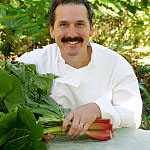Canning Fall
 The summer that I first discovered home preserving, no produce was safe. There was something so gratifying about containing brightly colored fruits and vegetables in clear glass jars that I wanted to preserve everything in sight.
The summer that I first discovered home preserving, no produce was safe. There was something so gratifying about containing brightly colored fruits and vegetables in clear glass jars that I wanted to preserve everything in sight.
Apples from neglected trees all over the neighborhood were captured in jars of sauce. I didn’t wait for tomatoes to ripen but boiled them instead with spices and onions to make green tomato chutney. Ripe peaches were transformed into more chutney, and cauliflower gleaned from a friend’s garden made a wonderfully weird pickle that looked like a specimen in formaldehyde. Even the ubiquitous Himalaya blackberry vines were hard-pressed to produce enough fruit for my insatiable urge to put them into jars.
My little laundry room-turned-pantry soon overflowed with jars. Dilled green beans, pale pie cherries, pickled carrot sticks, and half a dozen varieties of jams and jellies made a sparkling patchwork of the room’s shelf-lined walls.
The days of serious canning might be over; but for a new generation, the age of leisure canning has just begun. Most people who practice home preserving today put up only small amounts of food from their local farmer’s markets and grocers–who are now carrying more fresh, local organic produce than ever. It is no longer necessary, nor practical for some people to make twenty quarts of applesauce or tomatoes; but six jars of organic, Washington grown blackberry jam or twelve pints of pickles are prized possessions in the kitchen cupboard, and they make great last-minute gifts.
If you dare risk developing a habit that might become an obsession, you might consider getting started with a few jars of Washington-grown organic apple jelly. Organic apples are preferred, of course, for their taste and freshness. There is nothing else that so thoroughly captures the rustic charm of Pacific Northwest cooking, and nothing evokes the feeling of fall more thoroughly than apple jelly. From sterilizing jars to filling them with your homemade jelly, the whole process will be over in well under an hour and if you can keep it hidden, the jelly will last for well over a year.
CAA Contributor Greg Atkinson, Author and Organic Recipe Consultant. Greg is an author of West Coast Cooking and has served as executive chef at Seattle’s venerable Canlis restaurant. He also develops menu items for Organic to Go, a burgeoning chain of take-out restaurants, and is an organic recipe consultant for Tilth Producers of Washington, a membership organization of over 500 Washington growers, which fosters and promotes ecologically sound, sustainable agriculture in the interests of environmental preservation, human health, and social equity.
Comments (0)
0